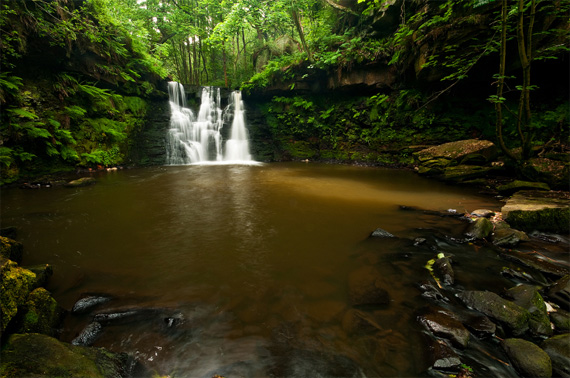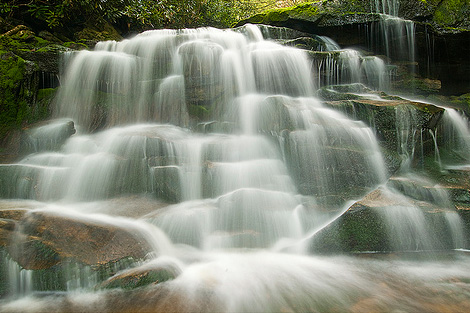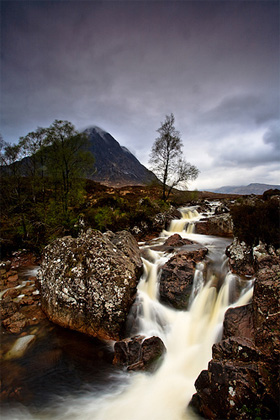Waterfall photography is a favourite subject for many a nature photographer. In fact, a good waterfall can be a magnet for almost anyone with a camera.
Like any subject in nature photography, waterfall photos also come with their own set of challenges. A beginner can be disappointed with their results time and time again, simply due to simple mistakes that can be easily overcome. Really good waterfall photography is not about expensive equipment or hi-tech methods; just a decent camera and a basic understanding of a few manual settings.

“Pool of Light” captured by Tony Taffinder (Click Image to Find Photographer)
In fact, a really good waterfall photograph probably owes more to good lighting and composition than to technology. This is great news; it means you can improve your waterfall photos no matter what sort of camera you have! Here are five simple tips to help you take some great waterfall photos of your own.
Waterfall Photography Tip #1. Choose the Right Weather Conditions.
Many waterfalls are found in the rain forest, or in heavily wooded areas. That means the same rules of lighting that apply to rain forest photography also apply to waterfall photos. Most of the time you will get your best photos in overcast weather. Cloud cover creates even, low-contrast lighting that eliminates harsh patches of light and shade from your waterfall image. While we are on the subject of lighting; avoid using your flash in most situations. It will destroy the atmosphere created by the natural light.
You should also try to avoid windy days. If you are working with a slow shutter (see tip #2), you don’t want the trees to be blowing about and blurring the background in your photo.

“Shays #2″ captured by Joseph Rossbach (Click Image to Find Photographer)
Waterfall Photography Tip #2. Experiment With Shutter Speeds and Carry a Tripod.
You have surely seen the soft wispy effect photographers create by shooting flowing water at very slow shutter speeds. This is a popular technique and has great impact for some photos. However, it is not the only method you should try. Some photos can look great, but if you do all your photos this way it can become boring and repetitive. Also, the wispy effect just doesn’t suit every waterfall. In my experience, cascading waterfalls that tumble over rocks and have several levels look great at slow speeds. I usually a shutter speed of one second. However, waterfalls that fall straight down over a ledge into a pool usually look better with a bit more definition; try a speed of about 30/sec or 15/sec. Experimenting with different speeds will always get you the best result in the end.
Regardless of the effect you are after, you should always have your tripod with you for waterfall photography. If you are in the forest on a cloudy day, the level of light will be very low, and you may find yourself forced to use very slow shutter speeds whether you like it or not.
Waterfall Photography Tip #3. Explore Downstream.
When you arrive at your location, the first instinct is usually to stand right in front of the waterfall and take the most straightforward angle. However, the best result is often found when you explore downstream. You may find an angle where the stream cascades toward you, with the main waterfall in the background. Or you may be able to frame waterfall through the branches of the trees. There really is no end to the possibilities; the point is, there is never only one shot to take at a waterfall, and the obvious photo is not always the best.

“Buachaille Etive Mor” captured by KennethVerburg.nl (Click Image to Find Photographer)
Waterfall Photography Tip #4. Put Your Wide-Angle Lens To Work.
A wide-angle lens comes in handy for a few reasons. Firstly, it has a naturally strong depth of field. If you are using a slow shutter speed for the water, it is important to keep the rest of the photo sharp. If your main subject is moving and the surroundings are out of focus, your result will just be a big blur. Secondly, the wide-angle lens has an exaggerated sense of perspective, allowing your viewer to feel that they are looking up the stream or into the rain forest, not just at a flat picture.
Waterfall Photography Tip #5. Let The Flow Of Water Shape Your Composition.
Whenever you compose a photo, you use the lines and shapes in the picture to create the best impact. The direction of movement in the water can create a powerful visual flow in your photograph. The viewer’s eye will naturally follow the direction of the water, so you should use this to help shape your composition. If you stand downstream so that the stream flows toward the camera, you can create a distinct visual direction in your composition that will truly catch and lead the eye of the viewer.
So, there you have five very simple ways to take better waterfall photos. As in all nature photography, writing and reading about it is never as inspiring as getting out and doing it. I hope these tips give you some motivation to grab a friend, get out there and practice. Have fun!
About the Author:
Andrew Goodall writes for http://www.naturesimage.com.au and is a nature photographer based in Australia. He manages a gallery in Montville full of landscape photography from throughout Australia.
Go to full article: Tips For Better Waterfall Photos
What are your thoughts on this article? Join the discussion on Facebook or Google+
Article from: PictureCorrect Photography Tips




No comments:
Post a Comment